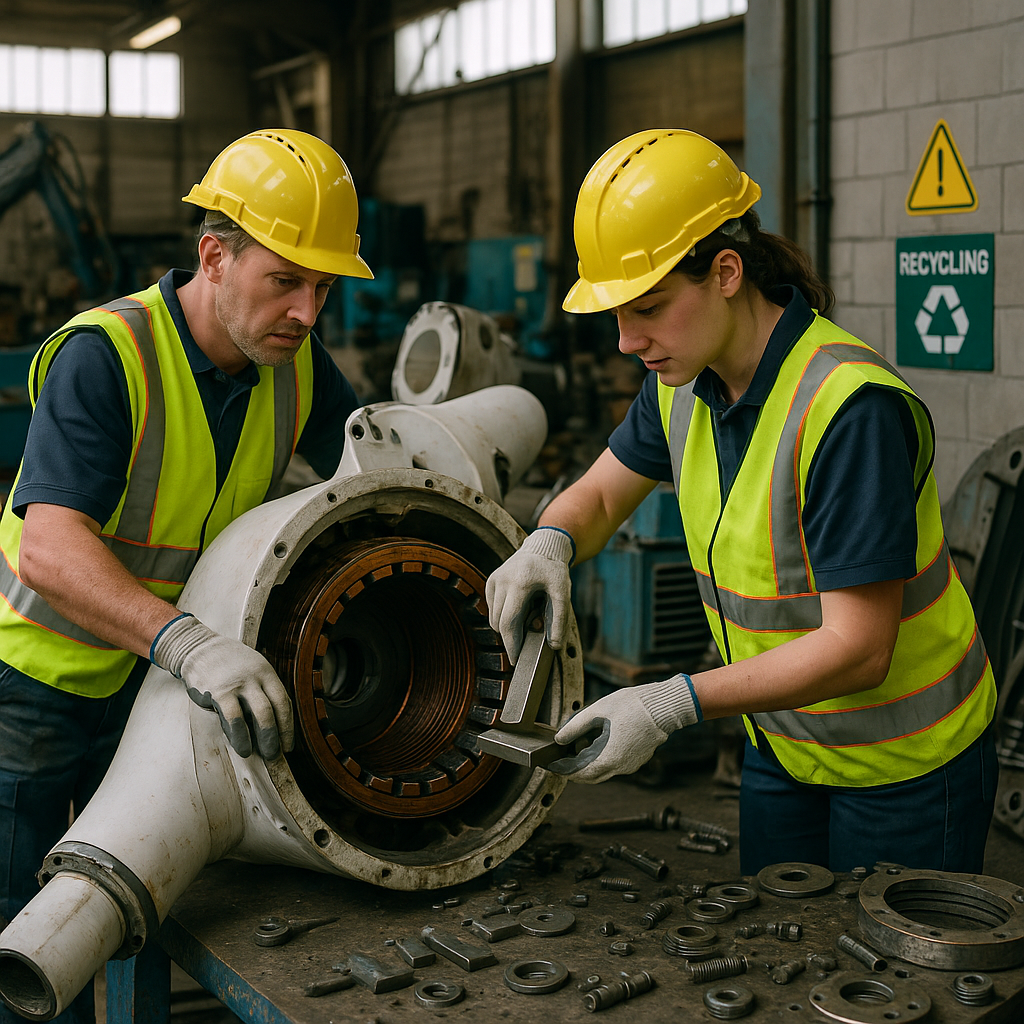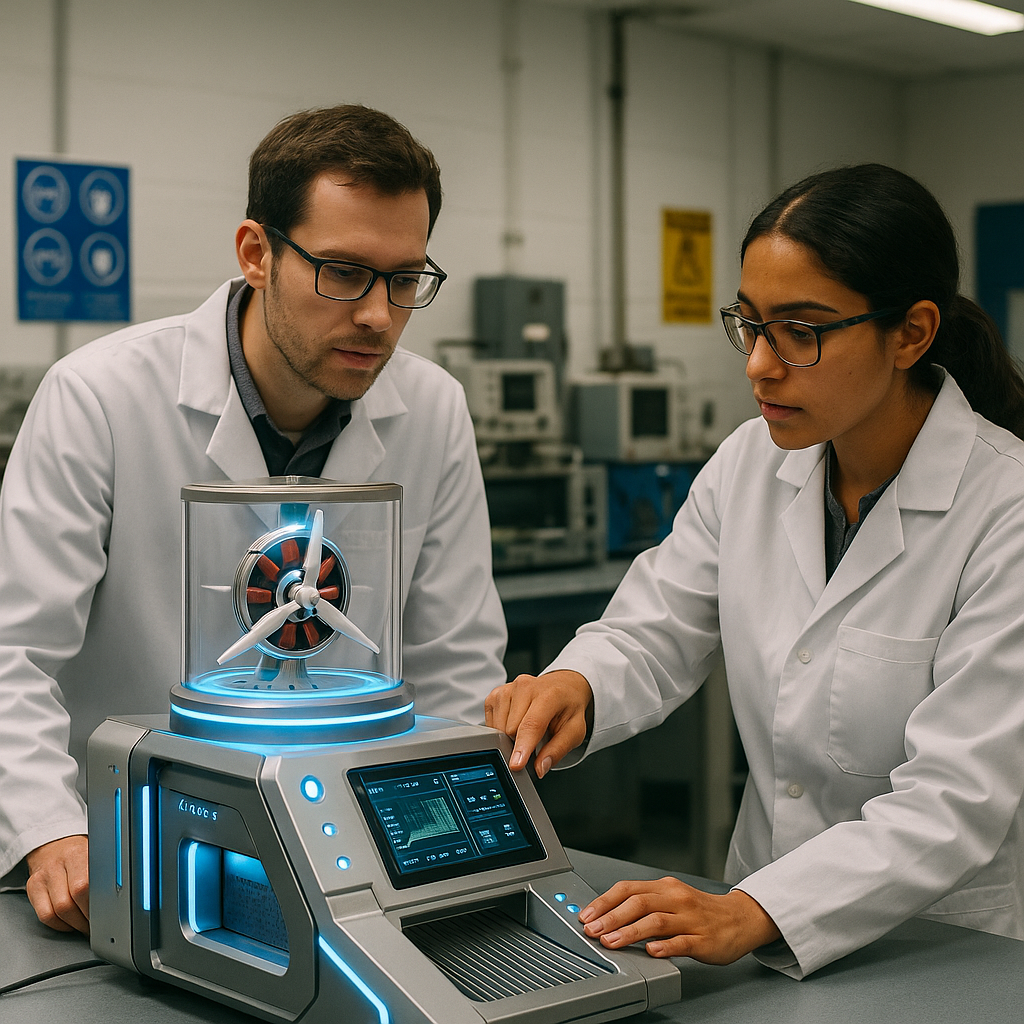5901 Botham Jean Blvd, Dallas, TX 75215
What is the Current State of Wind Turbine Magnet Recycling?
September 12, 2025Wind energy has become a cornerstone of America’s renewable power strategy. With over 70,000 wind turbines spinning across the United States, these giants are transforming our energy landscape. They generate more than 10% of the nation’s electricity and stand as visible symbols of our commitment to cleaner power.
These impressive structures, however, don’t last forever. As the first generation of commercial wind turbines approaches the end of their 30-year lifespans, a new challenge emerges. What happens to their valuable components when they’re decommissioned?
What Are the Main Challenges in Recycling Wind Turbine Magnets?

Recycling wind turbine magnets presents a complex set of obstacles that impact the sustainability of wind energy. The technical composition of these magnets makes recycling particularly difficult. Many contain neodymium, dysprosium, and other rare earth elements that require specialized separation processes.
A primary hurdle is the lack of established recycling infrastructure. Unlike common materials such as aluminum or steel, rare earth magnets have few dedicated collection and processing facilities. This shortage creates a bottleneck in the recycling pipeline even when materials are available.
Wind farm dismantling presents logistical complications. Turbines are often located in remote areas, making collection costly and time-consuming. Each turbine contains up to 4 tonnes of permanent magnets embedded within larger components. Extracting these magnets requires specialized equipment and expertise.
Technical and Operational Challenges
The separation of rare earth elements remains technically demanding. Current methods face several obstacles:
- Hydrometallurgical processes use acids to dissolve and separate elements but generate significant hazardous waste
- Pyrometallurgical approaches require high energy inputs, increasing the carbon footprint of recycling
- Direct recycling methods struggle with quality control when processing degraded magnets
The varying lifespans of turbine components further complicate recycling planning. While some parts may function for decades, others require earlier replacement. This asynchronous retirement creates unpredictable material flows that challenge efficient recycling operations.
Economic Viability Concerns
Cost effectiveness remains a significant barrier. Current recycling processes often cost more than mining new materials. Small-scale operations struggle to achieve economies of scale, making commercial viability difficult. The transportation costs for moving heavy magnetic materials from remote wind farms to processing facilities add to the financial burden.
Price volatility in the rare earth market creates uncertainty for recycling investments. When primary material prices drop, recycled alternatives become less competitive. This unpredictable economic landscape discourages long-term capital investment in recycling technologies and facilities.
Environmental and Regulatory Challenges
Ironically, some current recycling methods create their own environmental problems. Chemical processes can generate wastewater and sludge. Without proper management, these byproducts risk creating new environmental hazards while attempting to solve others.
Regulatory frameworks have not kept pace with the growth of wind energy. The lack of standardized requirements for turbine design, material labeling, and end-of-life management creates inconsistent approaches across regions. This regulatory patchwork makes coordinated recycling programs difficult to implement.
Despite these challenges, innovative approaches are emerging. Hydrogen decrepitation technology shows promise for eco-friendly processing. Combined pyro-hydrometallurgical methods help overcome individual limitations. Direct magnet-to-magnet recycling reduces material losses when conditions allow.
Tackling these obstacles will require collaborative efforts across the value chain. Manufacturers, wind farm operators, recycling companies, and regulators must work together to create viable solutions. With rare earth magnets essential to efficient wind energy, developing effective recycling pathways is crucial for truly sustainable renewable energy.
What Innovative Solutions are Being Developed?

The recycling industry is making significant strides in developing sustainable methods to recover valuable materials from wind turbine magnets. As these massive clean energy structures reach the end of their 30-year lifespans, innovative recycling technologies are emerging to ensure their components don’t end up in landfills.
Acid-free dissolution recycling represents a breakthrough approach for processing rare-earth magnets. Unlike conventional recycling methods that rely on corrosive acids, this gentler process selectively extracts rare-earth elements like neodymium, praseodymium, and dysprosium from used magnets. The technology produces high-purity oxides that can be directly used in new magnet production, creating a closed material loop that reduces the need for mining virgin materials.
Companies like Critical Materials Recycling have demonstrated the commercial potential of acid-free dissolution. Their process creates virtually no hazardous waste while recovering critical materials that would otherwise be lost. This approach is particularly valuable for regions with substantial wind energy infrastructure but limited access to raw rare-earth materials.
Hydrogen decrepitation offers another promising pathway for magnet recycling. This process uses hydrogen gas to break down magnets into powder form without melting or using harsh chemicals. When hydrogen enters the material’s structure, it causes volumetric expansion that effectively pulverizes the magnet. The resulting powder can then be reprocessed into new magnetic products.
Research shows that magnets recycled through hydrogen decrepitation can achieve impressive environmental benefits. Life cycle assessments reveal that this technique can reduce climate change impacts by 26-33% compared to manufacturing magnets from virgin materials. The process preserves the material’s magnetic properties while minimizing energy consumption and waste generation.
Some companies are exploring direct reuse strategies as well. Rather than breaking down wind turbine magnets into their constituent elements, these approaches repurpose intact magnets for different applications. This might involve reshaping generator magnets for use in industrial actuators or other equipment that requires strong permanent magnets.
Comprehensive recycling solutions often combine several approaches. The most effective systems involve partnerships between wind turbine operators, decommissioning specialists, and recycling facilities. Together, these stakeholders can process entire turbines, ensuring that valuable materials like copper, steel, and rare-earth elements all find new life in the circular economy.
These innovations are critical for the long-term sustainability of wind energy. By 2035, thousands of tons of wind turbine components will reach end-of-life status, creating both a challenge and an opportunity for recycling technologies. The continued development of these methods will help ensure that clean energy remains environmentally responsible throughout its complete lifecycle.
What is the Potential Impact of Successful Recycling?
Successful recycling of wind turbine magnets offers transformative environmental and economic benefits that extend far beyond the wind energy sector. The impact of these recycling efforts creates a ripple effect through supply chains, environmental conservation, and economic development.
Life cycle assessments show that magnet-to-magnet recycling has dramatically lower environmental impacts than virgin magnet production across all categories. Recycled magnets can achieve up to 95% reduction in CO2 emissions compared to newly manufactured magnets. This remarkable decrease stems from eliminating energy-intensive mining and processing operations that are necessary for new magnet production.
The environmental footprint of recycled magnet production is at least 50% lower than primary production, with particular benefits in reducing energy consumption and greenhouse gas emissions. Studies demonstrate that recycled magnets can deliver up to 80% lower environmental impacts than primary-produced counterparts across most impact categories.
Beyond climate benefits, successful recycling addresses other pressing environmental concerns. Rare earth mining typically generates toxic waste and requires significant energy inputs. By keeping valuable materials in circulation rather than extracting new ones, recycling prevents soil and water contamination from mining activities while conserving finite resources.
From an economic standpoint, recycling creates a robust domestic supply chain for critical materials. The European Commission’s Critical Raw Materials Act targets recycling 15% of the EU’s annual consumption of raw materials by 2050. Such initiatives reduce dependence on foreign suppliers—particularly China, which dominates the global rare earth market—and mitigate supply risks associated with geopolitical tensions and market volatility.
The economics of recycling are becoming increasingly favorable. As companies like Vattenfall commit to 100% circular outflow of permanent magnets from decommissioned wind farms, infrastructure for collecting, processing, and reusing these materials is being established. This creates new business opportunities in the recycling sector and drives innovation in recycling technologies.
Several European and North American startups are developing innovative approaches to wind turbine magnet recycling. For example, Cyclic Materials has technology to recover rare earth elements from magnets and return them to the supply chain, while CAREMAG aims to recycle 2,000 tons of magnets and separate 5,000 tons of heavy rare earth concentrates from mining.
The financial impact is substantial. Direct melting, liquid metal extraction, and other advanced recycling methods provide cost-effective alternatives to primary production, especially as recycling technologies mature and achieve economies of scale. For countries with significant wind energy capacity like Germany, recycling could yield hundreds of tons of valuable rare earth elements by 2050.
How Can Policy and Industry Collaboration Improve Wind Turbine Recycling?

Technological innovation alone cannot solve the challenges of recycling wind turbine magnets—policy frameworks and industry partnerships are equally essential. As wind energy expands, coordinated action across the value chain will determine how effectively rare earth materials are recovered and reused. Without supportive regulations and infrastructure, many of the emerging recycling technologies may struggle to scale.
Governments play a critical role in shaping recycling outcomes. Policy mechanisms such as extended producer responsibility (EPR) can require turbine manufacturers to finance the collection and recycling of decommissioned components. This approach has already proven successful in the European Union’s electronic waste regulations, which ensure manufacturers share responsibility for the full lifecycle of their products. Similar policies in the United States could accelerate investment in recycling facilities and help build a consistent supply of materials for processing.
Standardization represents another key area for improvement. Designing turbines and magnets with recycling in mind—using fewer toxic materials, standardizing alloys, and including labeling systems—would streamline end-of-life processing. Industry-wide standards could enable recyclers to efficiently process magnets from multiple turbine manufacturers without complex customization.
Collaborations between public and private sectors are already emerging. For example, the U.S. Department of Energy’s Wind Turbine Materials Recycling Prize has incentivized startups and research groups to create innovative recovery methods. At the same time, large wind operators are beginning to partner directly with recycling companies to establish take-back programs. These initiatives demonstrate the potential of combining public funding, regulatory support, and private-sector expertise to build a sustainable recycling ecosystem.
International cooperation will also be vital. Since rare earth supply chains are global, recycling solutions must align across borders to avoid waste exports and ensure consistent quality standards. Countries that establish strong domestic recycling industries stand to reduce dependence on foreign material imports while also positioning themselves as leaders in the clean energy economy.
By combining forward-looking policies with industrial collaboration, the wind sector can overcome current bottlenecks in magnet recycling. This alignment will not only reduce environmental impacts but also strengthen supply chain security, making wind energy even more reliable and sustainable for future generations.
Conclusion
Wind turbine recycling presents both a challenge and an opportunity. While the magnets inside these machines contain rare and valuable materials, they also highlight the limitations of current recycling systems. With innovation, policy support, and industry collaboration, the wind energy sector can move toward a circular model that reuses critical resources and minimizes waste.
Ensure your wind turbines and components are responsibly recycled. Call Okon Recycling at 214-717-4083 to discuss sustainable recycling solutions today.
